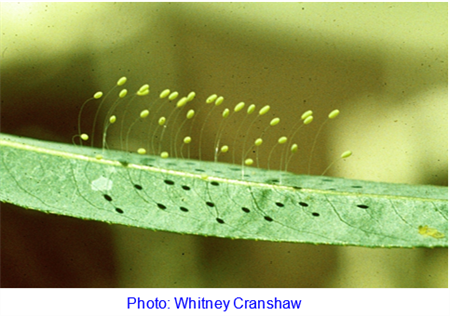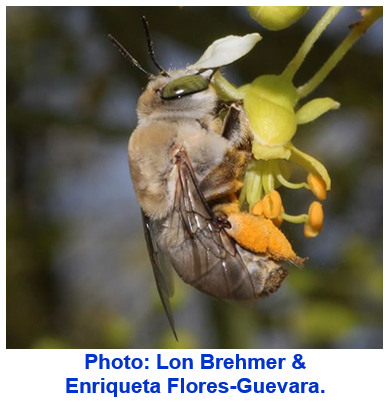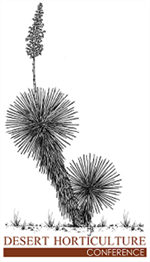View as PDF
View this email on our site
Subscribe to this newsletter
Dawn H. Gouge, W. Eugene Hall (Department of Entomology, University of Arizona) & Salvador Vitanza-Hedman
There are at least eleven species of kissing bugs (Figure 1) in the United States, and most are capable of carrying the parasite Trypanosoma cruzi that causes Chagas disease. However, there have been very few documented cases in which kissing bugs have transmitted the parasite to humans in the United States. While kissing bugs are considered to be a health concern, allergy reactions to bites remains the most significant hazard associated with the insects.
The geographical range of kissing bugs is changing due to land use and climate change, and the number of concerned citizens submitting pictures for identification has increased in recent years. Most citizen inquiries in Arizona received during 2021 turned out to be leaffooted bugs (Figure 2). To a lesser extent we also received submissions of harmless assassin bugs (Figure 3) and milkweed bugs (Figure 4).
It is important to note that several common leaffooted bug species resemble kissing bugs in appearance.




Leaffooted bugs are in the insect family Coreidae, while assassin and kissing bugs are in the family Reduviidae. Bugs in both families have impressive tubular piercing and sucking mouthparts that form a rostrum. The leaffooted bug rostrum is held under the body when bugs are not actively feeding, and swings away from the body, pointing downward when feeding (Figure 2). However, assassin and kissing bugs have a three-segmented rostrum(Figure 5), leaffooted bugs have a four-segmented rostrum (Figure 6) comparatively longer, often extending more than half the length of the body.


Adults of common leaffooted bug species are ¾ to 1-inch in length (excluding the length of antennae). Leaffooted bugs, like many other terrestrial true bugs, have scent glands that generate a distinct odor. Both adults and nymphs emit defensive secretions and alarm pheromones. Many leaffooted bug species overwinter as adults emerging in spring from harborage locations. Adults are largely intent upon dispersing in search of fruits, vegetables, nuts, seeds, or ornamental flowers to feed on. Female bugs lay large numbers of eggs in clusters or rows throughout spring and summer. Nymphs emerge from the eggs in about a week and develop into adults over the following months. Population levels are influenced heavily by weather patterns and are generally higher after a mild winter. The availability of plants and abundance of natural enemies that naturally suppress bugs also influences populations.
Common leaffooted bugs (Figure 7) include:

Following, are tips to aid the identification of common leaffooted bugs:
What to look for: Adult leaffooted bugs have a 4-segmented rostrum (Figure 6), 4-segmented antennae (Figure 6), scent glands and clearly defined parallel veins in the membrane of the fore wings Figure 8).
What may or may not be present: Some, but not all leaffooted bug species have conspicuous legs with flattened leaf-like paddles on the hind legs (Figure 8). Similarly, an enlarged antennal segment may be observable in some species (Figure 7).
Immature nymphs: The hind legs may be slender in earlier stages or have subtle expansions of the hind legsthat become more obvious as they develop into adults, although not all species have the telltale flanges on rear legs even as adults. Immatures have external openings of scent glands visible as two projections or spots on the medial line of the upper surface of the abdomen (Figure 9).




If you know what this is, email the answer to Dawn at
dhgouge@email.arizona.edu. You will not win anything if you are correct, but
you will be listed as a “Master ID Detective” in the next newsletter issue.
The 5th Arizona School IPM Conference is being offered Online April 25th – May 31st, 2022.
This is a great opportunity for continuing education not only for schools and childcare, but also for community colleges, city parks and rec, turf and landscape managers, golf course supervisors, and other institutional staff engaged in operations, maintenance, turf and landscape, food service, health services and many other areas. The online format makes it accessible to persons anywhere in Arizona and other states.
Registration information and schedule are available at: https://acis.cals.arizona.edu/community-ipm/events/arizona-school-ipm-conference
6 or 12 AZ PMD/PUG/PUC/Registered Sanitarian CEUs (NEHA approved) will be available for license renewal. Registration is open through May 31st, 2022.
Please share the announcement with interested contacts.
Have a question?
Call 520-374-6299 or email nairs@arizona.edu
Shaku Nair
Coordinator, Arizona School IPM Conference
Offered by the University of Arizona
Live Online on May 13, 2022, and content available through June 24, 2022.

The Desert Horticulture Conference is the premier annual conference for all members of the southwest green industry: landscape architects, designers, growers, retailers, contractors, maintenance personnel, suppliers, and educators. Presenting timely and research-based information relevant for designing, building, maintaining, and producing plants for urban landscapes in the arid Southwest.
Ideal for professionals holding licenses or certifications. CEU’s will be available.
More information: https://cals.arizona.edu/deserthort/
May 24, 2022, 10:00 AM - 1:30 PM MST. Register at https://register.gotowebinar.com/register/7930153265782071822

During this event, EPA will re-broadcast three webinars: Rodents – Prevention and Control; Cockroach Allergens, Baits, and the Sweet Science of Glucose Aversion; and Fleas – Pet Annoyance and Public Health Threat. Following each webinar, participants can engage in a live Q&A with subject matter experts.
Rodents – Prevention and Control will focus on rodent prevention, monitoring, and management using IPM practices.
Cockroach Allergens, Baits and the Sweet Science of Glucose Aversion will examine cockroach allergens, glucose aversion, and insecticide resistance. Presenters will also discuss the best IPM tactics for controlling cockroaches in homes, schools, and other structures.
Fleas – Pet Annoyance and Public Health Threat will address health risks posed by fleas. Presenters will also explain how to identify, monitor, and manage fleas using an IPM approach.
View recordings of previous EPA Integrated Pest Management Webinars at https://www.epa.gov/managing-pests-schools/upcoming-integrated-pest-management-webinars.
For more information about the EPA Schools program: http://www.epa.gov/schools/.
To view all our previous newsletters, visit: https://acis.cals.arizona.edu/community-ipm/home-and-school-ipm-newsletters.
This material is in part funded by the National Institute of Food and Agriculture, U.S. Department of Agriculture, under award number 2017-70006-27145 that provides Extension IPM funding to the University of Arizona. Information regarding this document is within the guidelines of the Border 2020 Program funded by the U.S. Environmental Agency (EPA) and administered by NADB. Additional support is provided by the U.A. – Arizona Pest Management Center.
The Northeastern IPM Center receives support from the U.S. Department of Housing and Urban Development’s Office of Lead Hazard Control and Healthy Homes through the U.S. Department of Agriculture, NIFA agreement #2016-4866825905. Any opinions, findings, conclusions, or recommendations expressed in this publication are those of the authors and do not necessarily reflect the views of the U.S. Department of Agriculture or those of other funders.